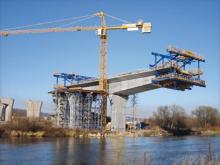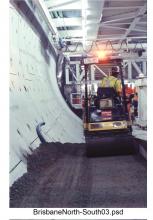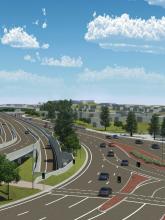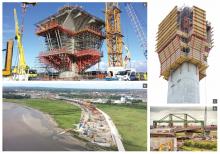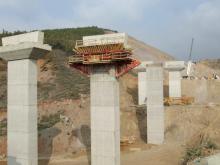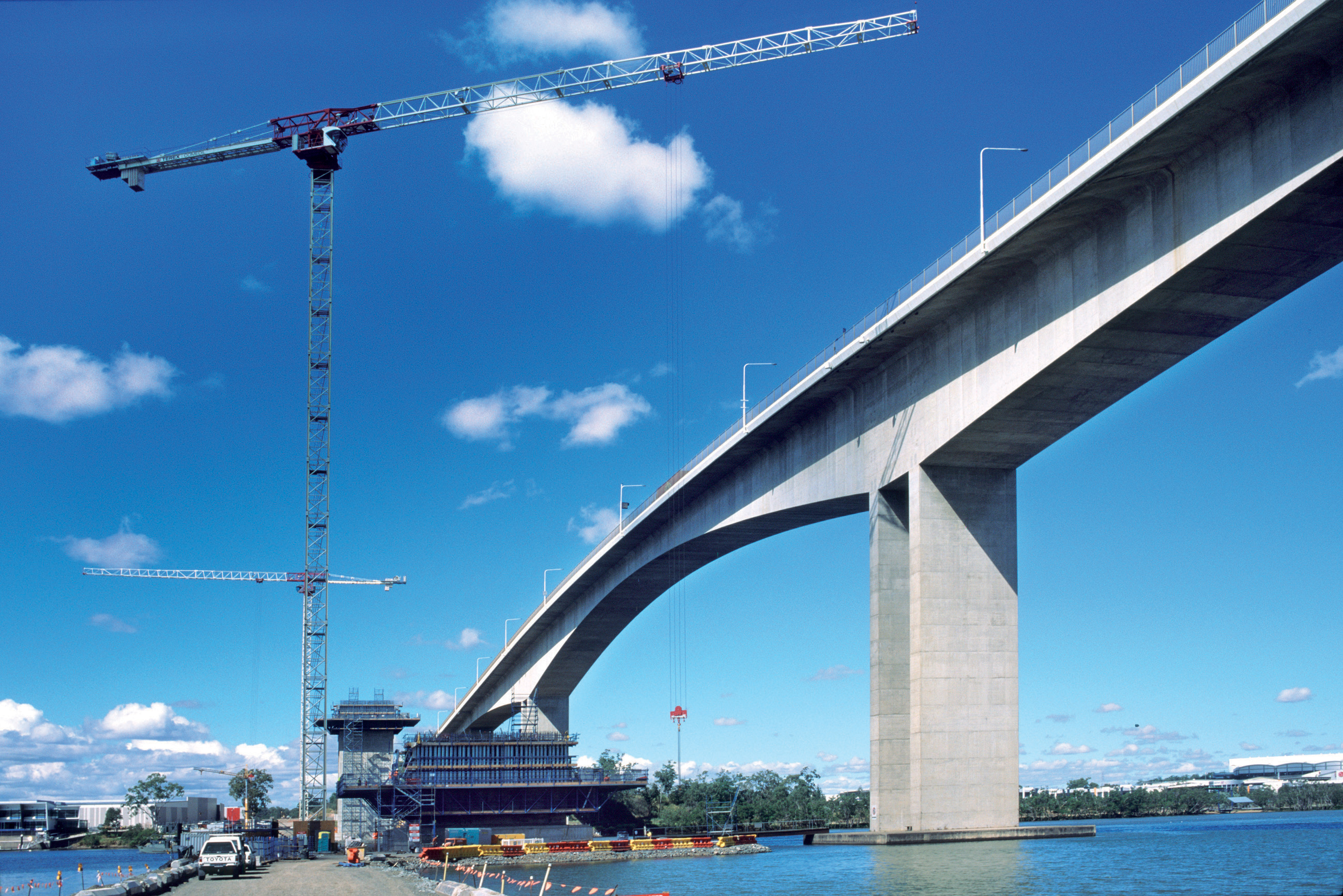
A massive AU$2 billion update of the Gateway Motorway in Queensland is underway to improve an infrastructure stretched by population boom. Report and photographs by Adrian Greeman
Just 20 years after the Australian city of Brisbane built its Gateway Motorway with a high slim signature bridge dominating the river skyline, the road is being completely revamped.Some 12km of urban route on the south of the Brisbane River is being expanded to take much increased traffic levels; the north is getting a completely new 7km section of motorway on a different alignment to bypass extra traffic, and tolls are being completely automated to speed flows.
At the heart of the project is a duplication of the 1.63km long Gateway Bridge itself, with its central slim soaring concrete arch, which was a world record holder in its time for a concrete box balanced cantilever bridge. The 260m long main span carrying three lanes of traffic each way nearly 65m above the river is still the biggest hollow concrete box construction anywhere.
The original bridge's new twin, just 50m downstream, brings the total road capacity to six lanes each way plus (on the new bridge) an extra width for a pedestrian and cycle way.
Doubled capacity on the main bridge will only partly be matched at this stage by the upgraded southern section's additional lanes, taking it from two to three, and in part from three to four, and by the additional traffic that can be accommodated on the second road link in the north. But sooner or later any spare capacity will be needed for further upgrades on either side of the river as traffic increases further.
Increases are already overdue. The south-east of Queensland, the huge semi-tropical coastal state north of Australia's largest city Sydney, has got the fastest growth rate in the country with a population rise of around 1,500 people/week, from overseas and Australian immigration. The climate, the landscape and the lifestyle features of the region make it highly attractive in the way that California is in the USA. Surfing beaches on the nearby Gold Coast and the Sunshine Coast northwards are major attractions, and the city has new cultural attractions.
But infrastructure has not kept up, and a major state government road and rail
investment programme is now underway: this includes the Gateway Motorway improvement. This, with 100,000 vehicles/day throughput, is at saturation point in the southern section and close to it on the bridge and the northern part. The existing northern line of the road also has to cope with traffic leaving and joining for the central city area.
The total AU$1.88 billion (US$1.8 billion) road improvement will ease congestion for commuters in the expansive Brisbane urban area, and for through traffic. The new route alignment will help longer distance drivers arriving from further north in the state who want to bypass the city for the Gold Coast and, on to the south, vice versa.
It will also help the growing Australia Trade Coast which includes the expanded (and expanding) Brisbane International Airport, the Port of Brisbane and a host of associated industries, which between them account for 40% of the traffic on the road.
"Container growth alone is 15% a year" says Phil Mumford, chief executive officer of the Queensland Motorways Company which is client for the project and the operator of both the crossing and a small network of motorways in the Brisbane area, including the Logan motorway linking into the southern end of the Gateway.
Helping further will be a new road into the airport to ease the near capacity airport boulevard. The new road is being built in a separate contract but there is a major interchange onto the new eastern loop of the Gateway so that non-city traffic will have a direct route into the airport.
Queensland Motorways was set up to build the original bridge and was deemed the best instrument for its extension. It is wholly-owned by the Queensland's state government but acts as an independent company and could be described as being in a public private partnership (PPP) with the government for the total project.
Its tender assessment for the construction was based on a value-for-money principle with a variety of international competitors bidding for the design and construct project, says Mumford. Eventual winner was a joint venture of Leighton Construction and
"We did not go for alliancing on this scheme but a conventional contract, though it was assessed on a variety of factors including cost but also risk and innovation," says Mumford.
Alliancing is a form of partnering used in Australia with a fixed price arrangement created for the work and a pain/gain mechanism for overruns or savings. But it is needed when the project design is not well delineated, which was not the case for the upgrade, points out Mumford.
The project was awarded in September 2006 with an eventual completion in 2011. There are a number of intermediate completion dates however, particularly on the southern section widening which is being completed and opened in stages. Work on site began in March 2007.
The most visible element of the construction is naturally the bridge, which forms a self-contained element within the project. It is being built in a AU$350 million (US$336 million) contract by main contractor, the joint venture of the
Unusually the Leighton-Abigroup JV is using alliancing with VSL on the bridge job, as it is on some other sections of the work. It believes that the tie-in will give a better result than conventional subcontracting.
The decision to duplicate the bridge almost identically to the old one, rather than add a new and possibly very different crossing, is due to a variety of factors, not least the iconic significance of the original which was seen as symbolic of the city and Queensland's growth and progress in the late 20th century, and part of a programme to turn it from a parochial town into a world city.
"You either have to have to leave that symbolism untouched or do something stunningly different" says Mark Palmer, deputy project director with the LAJV.
But "different" was virtually ruled out because of the severe constraints at the site. The Brisbane airport nearby has a flight path requirement which sets a maximum 80m height on any structure while the river navigation limits it the other way: the central channel is 14m deep which means fairly large passenger cruisers can pass, requiring a 55m clearance above water level. The narrow envelope that remains accommodates few other options and certainly not the cable stay towers that might be needed, for example.
So a repeat it is, to be built over a three and a half year period, two years faster than the original.
The new bridge will be almost a complete shadow of the original outline, but with a couple of differences. To begin with it is wider: at 28m rather than 25m, the extra width is for the combined bicycle and pedestrian path, and lookout points along its length to let people enjoy the view from the 64.5m high central point.
To cope with the width, the cross section will be a double box (15m wide) rather than the huge single box section of the original, which was 12m wide at the bottom. For the main bridge span and the two back spans of 130m this double cell will be cast in one unit for each pour during a balanced cantilever construction process, gradually extending the spans outwards.
"We are using in situ concrete construction for this because the depths are too big for precast segmental construction even at the slimmest central part where it is 5m deep," says Gerry van der Wal, the LAJV manager for the Gateway Bridge Alliance. At pier heads the box section will be a massive 15m deep, and will have highly complex reinforcement to cope with the loads as the cantilevers move outwards. Each one will take three months to do.
They sit on a 45m column, the highest of the 17 columns, which gives the bridge an approximate height of 60m at that point, rising further in the centre.
Side spans for the bridge will also be built with balanced cantilever, but using precast units to form the 77m spans between the approach piers, some five on the south side for a 350m approach and ten on the north where the approach is 750m long.
The two boxes making up the spans will be made with separate segments as two independent structures, until the spans are complete when the two sides will be stitch concreted together to form a continuous structure.
An assembly gantry spanning two piers and cantilevering outwards will build the deck by lifting lift one segment at a time. A segment will be added to the span at the back, then the front. This will be repeated on the other side, equally front and back so that the whole bridge pier is always only one segment off balance at most. Each segment is pre-stressed in position before its span is extended further.
The assembly gantry is being made in China, says van der Wal. The 165m long truss structure is 6m deep with travelling 'spider' grabs for lifting the segments.
Deck segments are being cast in a special precast facility built in the main site yard on the north side of the river. They are match cast, which is to say poured against the one already made, to ensure an absolutely tight fit, the first time this system has been used in Australia.
Most units are around 65tonnes, although some expansion joint segments are especially large, weighing up to 200tonnes.
A test span has been done using a mobile crane to lift the segments. The gantry is currently in preparation.
Meanwhile, foundation work has just finished for the main piers which are beginning to rise, using jump forms, from the big 17m by 19m pile caps. The piers are twin hollow rectangular leaf piers each 18m wide and 8m deep.
Foundations are highly refined over the original bridge, with fewer, slightly larger piles. It is an aspect noted particularly by Peter Rotolone, Queensland Motorway's client side construction manager for structures. He worked on the original bridge in the early 1980s.
"Here we have 24 bored piles of 1.8m in diameter whereas the old bridge, which is slightly smaller in width, has 48 piles of 1.5m," he explains.
To ensure the integrity of the foundations the client has insisted on a separate test bore for each pile to verify the position of the rockhead, and on a comprehensive programme of testing, including special sacrificial piles being made for testing load capacity.
Piles, which are up to 55m in length, were also being inspected during construction with TV units to ensure the cleanliness of the bores.
Side span piers, which have to take smaller loads, are mainly founded on driven concrete piles, 45 per pier. The octagonal piles have also been made in the precast facility.
A huge number of piles have also been required for the areas just north of the bridge where soft ground has needed substantial improvement work. The 11,000 piles are part of an enormous ground improvement programme throughout the northern sector of the project, and which has seen almost as much work taking place as for the main bridge.
The problem is that the northern section of the motorway, and especially a completely new 7km loop of road which will complement the existing route, takes half of the overall traffic before merging back to join the main route.
The new alignment runs over very soft marshy ground, essentially the flood plain of the Brisbane River, and is characterised by deposits of extremely thick marine clay with the consistency of "wet toothpaste," according to one project engineer.
Not only must the road run on this ground, mainly on a 3m high embankment to keep it clear of any flooding, but also be founded on a number of major structures: some 26 bridges in total making up three significant crossings and interchanges.
A crossing is needed for the existing airport road and the Skytrain elevated rail line to the airport, for example. Another major interchange will connect into the new airport road that is soon to be constructed and a 750m bridge is needed at the end to pass over a major canal.
Free-flow toll system
Tolling and control systems for the new upgraded motorway will be state-of-the-art. For the tolling, international supplier Thales will provide a free-flow electronic system based on optical recognition of number plates and electronic transponder tags for frequent and regular customers. It will be a single point system using gantries at the bridge.
Thales is working with the
"That is something the rest of the world has struggled with," says Phil Mumford.
The control system for the road will be an integrated system including CCTV, road loop detectors, and with STREAMS incident detection. Variable speed signs and variable message signs will be installed and travel time signage will give drivers updated information.
"We chose

